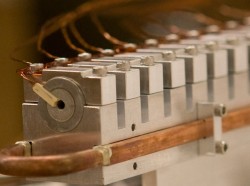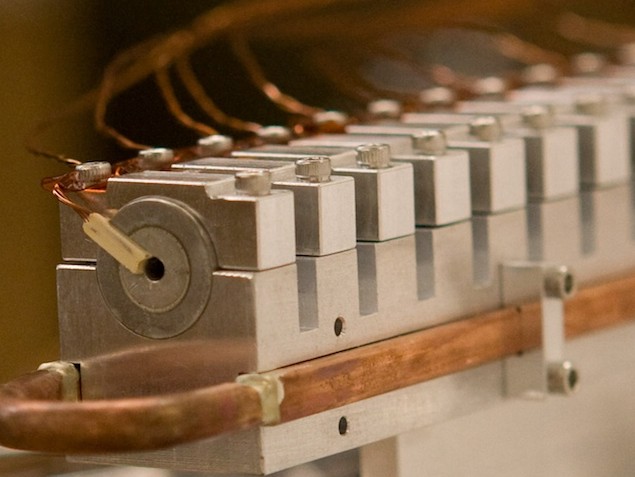Stopping and Freezing a Bullet
The cooling of atoms to near absolute zero has been possible thanks largely to laser-based techniques, but only about 10 percent of elements in the periodic table have the necessary atomic level structure. A new two-step technique, described in two back-to-back papers in the 7 March Physical Review Letters, promises to cool atoms representing 90 percent of the elements. As a demonstration, the researchers slowed a beam of atoms with a magnetic braking system, and then–working with a separate sample–showed how to cool the atoms further in the process of switching them from one trap to another. Although the steps have yet to be combined, the team believes their method could cool atoms like hydrogen that have proven difficult to work with using traditional means.
Laser cooling has revolutionized atomic physics research and led to the creation of bizarre quantum systems like the Bose-Einstein condensate. Bouncing laser photons off of atoms can cool them to the microkelvin regime by slowing down their motion. But the atoms must consistently return to their initial internal state after each scattering event. Most atom species have multiple final states, which interferes with cycling, so researchers have devised other ways to slow and cool gases using receding walls or electric field pulses, for example. But there’s no simple, one-size-fits-all solution that can handle a wide range of atoms.
Now Mark Raizen of the University of Texas at Austin and his colleagues think they may have come pretty close to one. Any atom with an unpaired electron is paramagnetic, meaning it has a magnetic dipole–a sort of internal bar magnet that will line up with an external magnetic field. About 90 percent of the elements in the periodic table are paramagnetic in their ground states, and many simple molecules are paramagnetic as well. Raizen’s team has developed a program to slow paramagnetic particles–usually the first step to making cold atoms or molecules–and then trap them at low temperature.
In the first of their two papers, Raizen’s team describes using magnetic field pulses to slow bunches of excited, paramagnetic neon atoms that were shot like bullets through their apparatus. The bunches went through the centers of 64 coils of wire that each produced a microsecond pulse of 5 teslas just as a bunch passed by. The principle is similar to coilguns being developed by the military to launch projectiles, only “in reverse,” Raizen says. To those atoms with their dipoles aligned opposite the beam’s direction, the pulses are like hills they have to climb, except that each hill disappears before the atoms have a chance to slide “downhill.” Other groups have been working on atomic coilguns, but Raizen’s group is the first to significantly slow down a beam, from 450 to 56 meters per second, which is a 98 percent reduction in kinetic energy.
Eventually the team plans to stop an atom bunch completely, so it can be loaded into a magnetic trap at a temperature of around 100 millikelvin. Their second paper describes a proof-of-principle demonstration of the next cooling step using rubidium atoms in a magnetic trap. Above the rubidium atoms, the researchers placed an optical trap they designed, a 100-micron-wide “box” whose walls were six laser “sheets.” Atoms could drift through the walls but would then encounter another laser that switched their internal state into one that was repelled by the walls–a system that can work with most atom types.
The researchers slowly lowered their optical trap to “skim off” the slow-moving atoms at the upper edge of the magnetic trap, a bit like grabbing bouncing balls at the top of their flight, when they have the least kinetic energy. They extracted 150,000 atoms at a temperature of 7 microkelvin–concentrating these coldest atoms by many times, compared with the magnetic trap, according to the team. Raizen plans to someday combine the gun and optical trap to cool tritium, a radioactive isotope of hydrogen, because measurements of its decay would help researchers determine the neutrino’s mass.
Claude Cohen-Tannoudji of the École Normale Supérieure in Paris thinks the papers are “a significant step for extending cooling and trapping methods to a lot of atomic and molecular systems.” But Kristian Helmerson of the National Institute of Standards and Technology in Gaithersburg, Maryland, says the work “is not the breakthrough that the field is needing” because it resembles previous “trap-swapping” schemes that have had limited cooling potential. Raizen admits his group’s method has some of those same limitations, but “its importance is that it can be applied to almost any species that can be magnetically trapped.”
–Michael Schirber
Michael Schirber is a Corresponding Editor for Physics Magazine based in Lyon, France.





